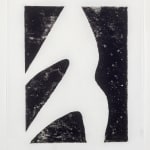A special pleasure, on this side of the Atlantic, was “
Vincent Barré: Maisons/Ateliers,” at Corkin Gallery, in Toronto, a group of small bronze sculptures that were the internationally known French artist’s response to the restrictions of the past two years. Barré divides his time between Paris, a large studio south of Paris, and a smaller one in Normandy. He spent the lockdown in Normandy, sitting, as he described it “on a little chair before a pot of boiling wax, molding objects from thin slabs of wax, which I bend, shape, and curve,” a near-meditative process that resulted in a series of potent volumetric forms, later cast in bronze, the
Retrait series. Barré, who often makes monumental cast iron works and has large public commissions to his credit, had made small bronzes before, but the pieces shown at Corkin, most about 18” high, were his largest to date. Elegantly displayed on minimalist tables and brackets designed by the artist, who was trained as an architect and studied with Louis Kahn, they evoked such disparate sources as primitive kitchen pots and Bronze Age armor, archaic sculpture, ancient tools, and domestic utensils, among many other objects from different cultures and periods, all scaled to the body and made to be handled and used. Barré is a widely traveled connoisseur of such diverse precedents, who has filled countless notebooks with exquisite drawings of
kouroi, ancient artifacts, and vernacular and devotional objects from Asia. Even more powerfully, the
Retrait sculptures’ blunt, sensual volumes also recalled the body, as if haunted by memories of the human figure.
As we moved around the works, some delicately balanced on slender “necks,” others with the overtones of sturdy limbs or voluptuous torsos, our associations were disrupted by volumes that revealed themselves as open “hulls”—Barré’s term—making us aware of the thinness of the bronze shell, of the relationship of interior to exterior, heightening our curiosity about the hidden parts of the inner space. We were shifted into the realm of abstraction, adding unequivocally Modernist associations to the echoes of the ancient past. Subtle patination, flushing into dull red or subsiding into near-black matteness, enhanced this sense of multivalence.
This kind of suggestive ambiguity is characteristic of Barré’s work and obtained, as well, in his crisp black-and-white monotypes, displayed in a separate space. Bold, graphic shapes, some like florid vegetation, others singular and expansive, were like flattened versions of the sculptures, their clean contours slightly softened by Barré’s process of repetitive stamping of the ink. Barré is well-known in France and elsewhere in Europe, but has shown very little in North America. The Corkin Gallery exhibition was a welcome antidote to that deficiency. Let’s hope there are more such occasions, perhaps even closer to home.


